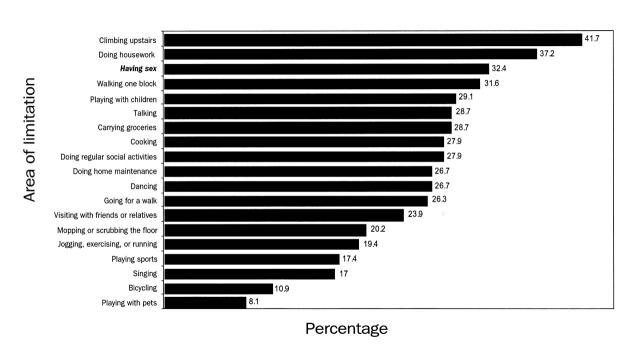Proper management of asthma aims at improving health and well-being and reducing limitation in daily living.1 However, despite previous reports,2–5 sexual limitation remains an area of asthma-related quality of life that is often neglected in both research and clinical practice. To evaluate the need for treatment and counseling regarding sexual functioning for patients with asthma, we assessed prevalence of self-reported sexual limitations among adults with asthma and examined their correlates.
We report the results of an asthma quality-of-life questionnaire administered to 356 respondents who visited the emergency department at the Harlem Hospital Center in New York City.6 The mean age of the respondents was 40 (SD = 14). Sixty-four percent were female, 93% were Black or African American, and 47% had an annual household income of $9000 or less. We used 19 items from the quality-of-life questionnaire7 to assess the extent to which respondents have been limited in a variety of activities (Figure 1 ▶), measured on a scale from 1 (“totally limited, couldn't do the activity at all”) to 7 (“not at all limited”). To assess the importance of activities, we asked respondents who reported limitations in at least 5 activities which activities were the 5 most important to them. Asthma severity was determined with National Asthma Education and Prevention Program 1997 guidelines that used criteria for self-reported sleep disturbances caused by asthma symptoms.1
FIGURE 1—
Importance of various areas of limitations due to asthma among emergency department users (n = 247).
Of the 285 (80%) respondents who reported sexual activity during the 2 weeks before the interview, 165 (58%) reported limitations in sexual functioning caused by asthma, and 120 (42%) reported no limitations. Of the 19 types of limitations due to asthma reported, sexual limitation was the 15th most frequently reported limitation, after activities such as jogging, playing sports, climbing stairs, and even carrying groceries. Despite the low ranking among activities endorsed, when respondents were asked to identify the 5 most important of their limited activities, sexual limitation was the third most often mentioned, after climbing upstairs and doing housework (Figure 1 ▶).
Sexual limitations caused by asthma were more prevalent among people with moderate or severe asthma compared with those with mild asthma (odds ratio [OR] = 2.5; 95% confidence interval [CI] = 1.5, 4.2), women compared with men (OR = 1.6; 95% CI = 1.0, 2.7), people older than 40 years compared with those 40 years old or younger (OR = 2.7; 95% CI = 1.6, 4.3), people with an income below $9000 as compared with those with an income of $9000 or higher (OR = 2.0; 95% CI = 1.1, 3.6), and those who reported indoor exposures to mold and mice as compared with those who did not (OR = 3.6; 95% CI = 1.7, 7.5; OR = 1.8; 95% CI = 1.1, 3.0, respectively).
This cross-sectional study of emergency department users was limited in its ability to assess causal relationships and in its generalizability to other patient populations in which asthma is better controlled. Nevertheless, with about two thirds of the sexually active respondents reporting limitations in sexual functioning because of asthma, our findings underscore that asthma-related limitation in sexual functioning represents an important aspect of quality of life for people with asthma. Clinicians and patients need to discuss sexual functioning as part of a quality-of-life assessment. Limitations in an individual's sexual functioning, like other limitations on quality of life, indicate that asthma is not well controlled. Further research needs to examine physiological correlates and causal mechanisms and suggest treatment options for both asthma-related sexual limitation and asthma exacerbation due to sexual activity.
Acknowledgments
This research was supported by a research grant from the National Heart, Lung, and Blood Institute (RO1 HL51492).
This brief reports on data from the REACH (Reducing Emergency Asthma Care in Harlem) project.
Peer Reviewed
I. H. Meyer formulated the hypothesis, conducted data analysis, and wrote the report. P. Sternfels conducted data analysis and cowrote the report. J. K. Fagan cowrote the report. J. G. Ford was the principal investigator and cowrote the report.
References
- 1.National Heart, Lung, and Blood Institute. Guidelines for the Diagnosis and Management of Asthma: Expert Panel Report 2. Bethesda, Md: National Institutes of Health; 1997. Publication 97-4051.
- 2.Thompson WL. Sexual problems in chronic respiratory disease: achieving and maintaining intimacy. Postgrad Med. 1986;79:41–52. [DOI] [PubMed] [Google Scholar]
- 3.Walbroehl GS. Sexual concerns of the patient with pulmonary disease. Postgrad Med. 1992;91:455–460. [DOI] [PubMed] [Google Scholar]
- 4.Symington IS, Kerr JW. Sexercise-induced asthma [letter]. Lancet. 1976;2(7987):693. [DOI] [PubMed] [Google Scholar]
- 5.Shah A, Sircar M. Postcoital asthma and rhinitis. Chest. 1991;100:1039–1041. [DOI] [PubMed] [Google Scholar]
- 6.Ford JG, Meyer IH, Sternfels P, et al. Patterns and predictors of asthma related emergency department use. Chest. 2001;120:1129–1135. [DOI] [PubMed] [Google Scholar]
- 7.Juniper EF, Guyatt GH, Ferrie PG, Griffith LE. Measuring quality of life in asthma. Am Rev Respir Dis. 1993;147:832–838. [DOI] [PubMed] [Google Scholar]



